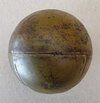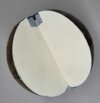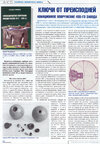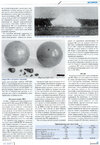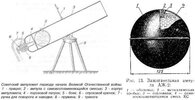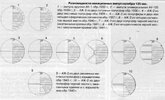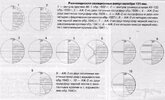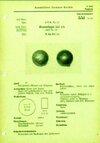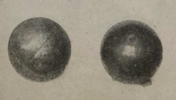pzgr40
Well-Known Member
The AZh-2 (АЖ-2) was a Russian incendiary bomb designed in 1939. The tests with this incendiary bomb were so promising that the Defense Committee demanded that the People's Commissariat for Munitions make factory No. 67 produce not 500,000, but 750,000 of these incendiary bombs per year before the end of the year. Due to a lack of thin sheet iron, the 'balls' were borrowed from the military chemical directorate, which preferred to store the 'balls' in an uncharged state due to the risk of poison gas leakage.
The shape of the incendiary device was a sphere with a diameter of 122 mm. The top consisted of a single part with a filler plug in the middle. The bottom of the sphere consisted of 4 segments of 90 degrees. The five segments were connected to each other by soft soldering. The wall thickness of the can was between 0.2 and 0.3 mm thick. The incendiary device was filled with a liter of a sticky fuel mixture called KS. KS consisted of kerosene mixed with white phosphorus, sulfur and tetraphosphorus (P5). This mixture was self-igniting and became hot between 800 and 1000 degrees Celsius. When it hit the ground or a target, the incendiary bomb tore open and the contents spontaneously began to burn fierce.
150 of these icendiary balls were loaded into the bomb bays in the wing roots of the IL-2 Sturmovik. The intention was to fly lengthwise over German tank and vehicle columns and set them on fire with a bombardment with these incendiaries. However, the AZh-2 incendiary bombs were not popular with the aircrews, as a stray bullet or shell splinter was enough to turn the aircraft into a flying flare. However, the AZh-2 was used frequently and successfully during the tank battle for Kursk.
There was also the ABK-P-500 dispenser in which 216 AZh-2 incendiaries could be loaded.
Regards, DJH
The shape of the incendiary device was a sphere with a diameter of 122 mm. The top consisted of a single part with a filler plug in the middle. The bottom of the sphere consisted of 4 segments of 90 degrees. The five segments were connected to each other by soft soldering. The wall thickness of the can was between 0.2 and 0.3 mm thick. The incendiary device was filled with a liter of a sticky fuel mixture called KS. KS consisted of kerosene mixed with white phosphorus, sulfur and tetraphosphorus (P5). This mixture was self-igniting and became hot between 800 and 1000 degrees Celsius. When it hit the ground or a target, the incendiary bomb tore open and the contents spontaneously began to burn fierce.
150 of these icendiary balls were loaded into the bomb bays in the wing roots of the IL-2 Sturmovik. The intention was to fly lengthwise over German tank and vehicle columns and set them on fire with a bombardment with these incendiaries. However, the AZh-2 incendiary bombs were not popular with the aircrews, as a stray bullet or shell splinter was enough to turn the aircraft into a flying flare. However, the AZh-2 was used frequently and successfully during the tank battle for Kursk.
There was also the ABK-P-500 dispenser in which 216 AZh-2 incendiaries could be loaded.
Regards, DJH

